by Tim Mosso
The crossbreeding of architecture and luxury watch design seems like a natural union of customer interest and commercial potential.
The developed economies and upper-income demographics targeted by watch manufacturers positively obsess over the built environment; it’s a cultural hegemon. Commercial real estate development, vanity homes, house remodeling as must-see TV, and the rise of celebrity “starchitects” attest to the depth of public interest, while architecture as a tourist pastime has become a standalone industry.
But compared to artist collaborations, motor vehicle co-branding, and themed designs for celebrity ambassadors, architecture rarely occupies the eye of luxury brands looking to expand their client bases. Given the disparity between boundless potential and the paucity of true architecture-driven watches, I find that an enthusiast’s survey of “arm’s-length” architecture case studies is in order.
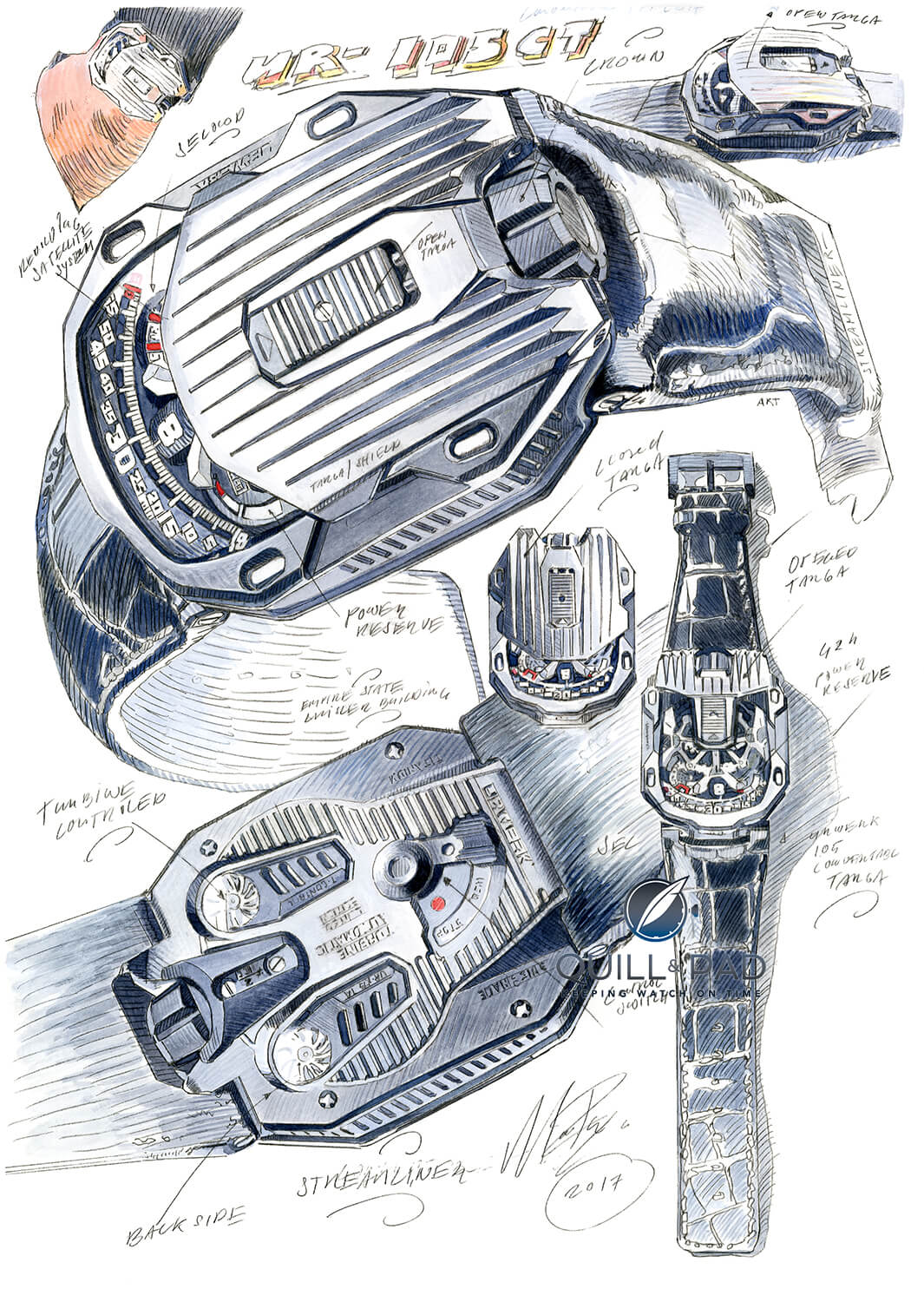
Urwerk UR-105 CT development sketches
SIHH 2019 provided an instructive example of architecture’s low-key role in watch design relative to well-worn tropes. For the third year in a row, parts of Geneva’s Palexpo felt like a Southern California cars-and-coffee event. One example is Roger Dubuis, who carted an entire Lamborghini Aventador into its exhibition space (the same space groaning under a rack’s worth of Pirelli tires in 2018).
Laurent Ferrier’s architectural Bridge One
Laurent Ferrier’s 2019 collection introduced at SIHH quietly took a different turn. Alongside an array of new dials for existing models, the new Bridge One shaped watch embodied a rare translation of architecture into a wrist-borne format. Expressly billed as a timepiece informed by Jean-Marie Gognoux’s 1876 footbridge the Passarelle de l’Ile of Geneva, Bridge One succeeded on two fronts.
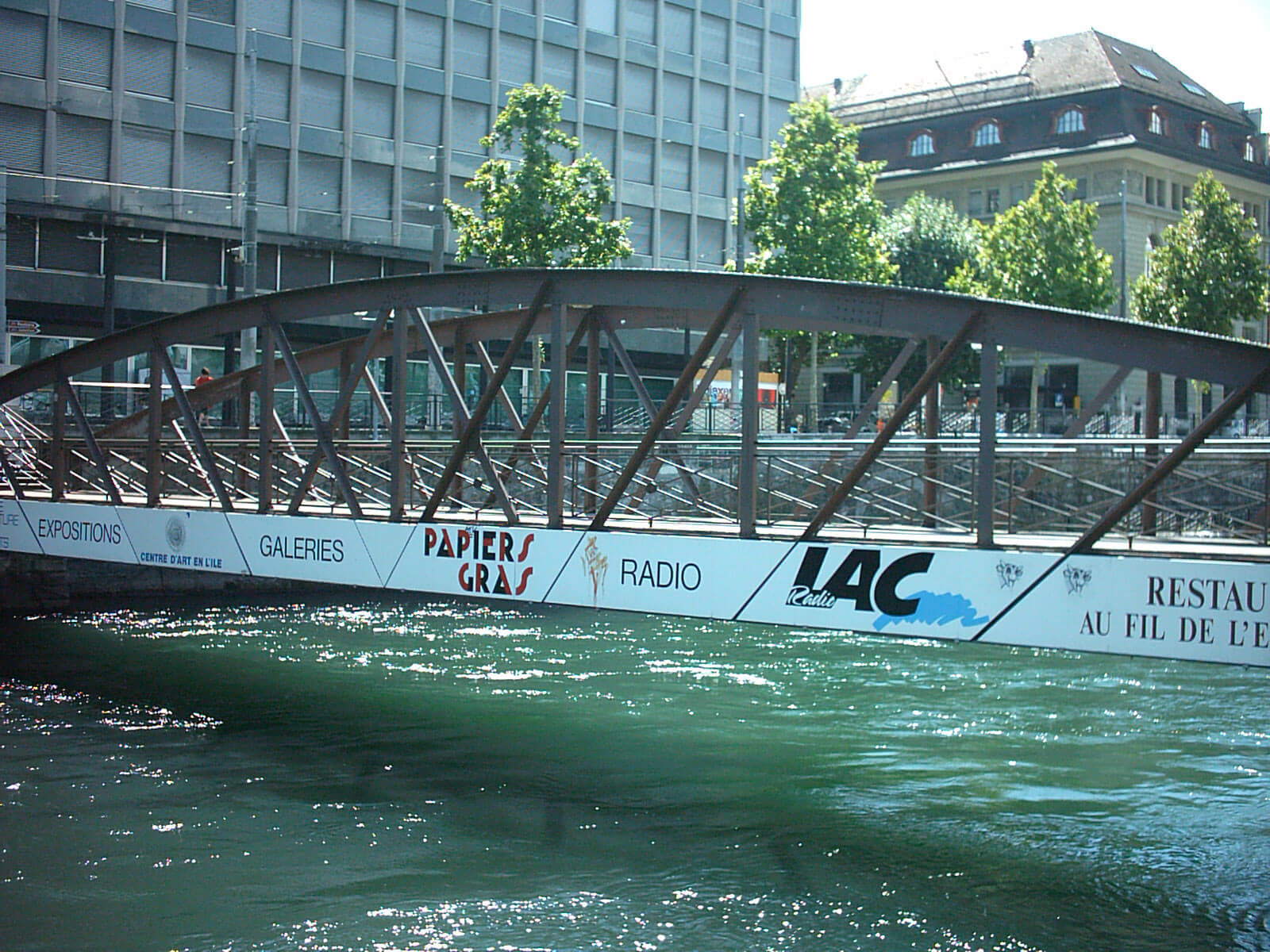
Passarelle de l’Ile footbridge in Geneva
First, the design of Bridge One triumphs on its own terms. It is organic, vaulted, sinuous in shape, and beautifully finished inside and out. Both the white enamel and grained grey dials complement the polish of the case with élan, and Laurent Ferrier’s shaped Caliber 107.01 upholds the brand’s reputation for uncompromising details.
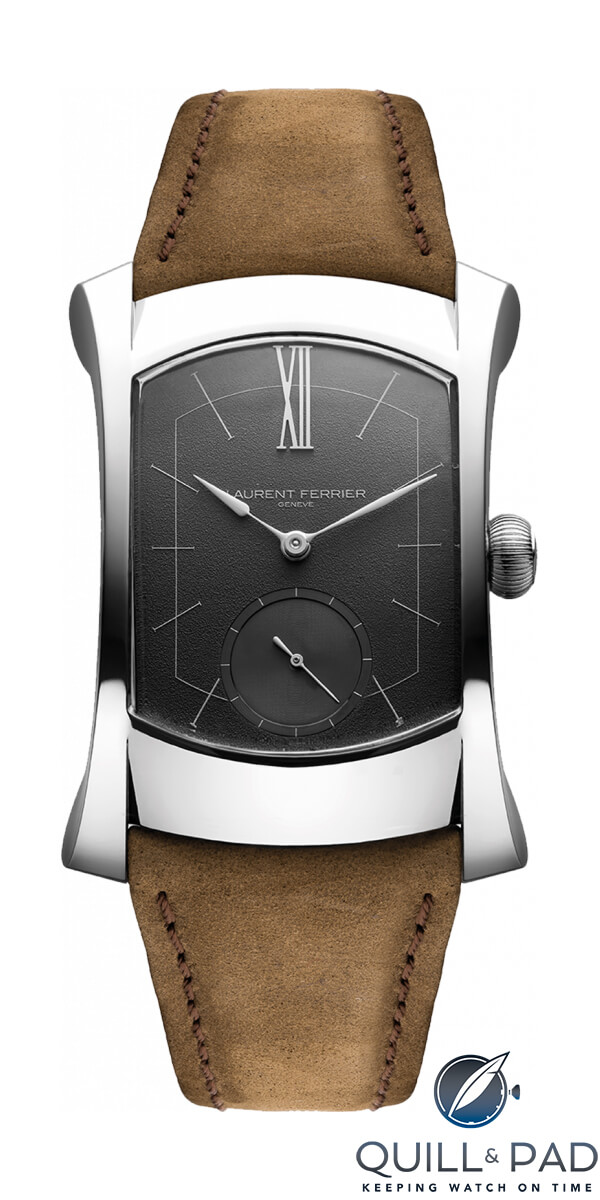
Laurent Ferrier Bridge One with grained gray dial
Absent any mention of the source material, a collector could draw logical parallels between the Bridge One and Patek Philippe’s 1997 Reference 5500 Pagoda; equally valid comparisons could be made to the organic sensibility of Marc Newson’s original Ikepods.
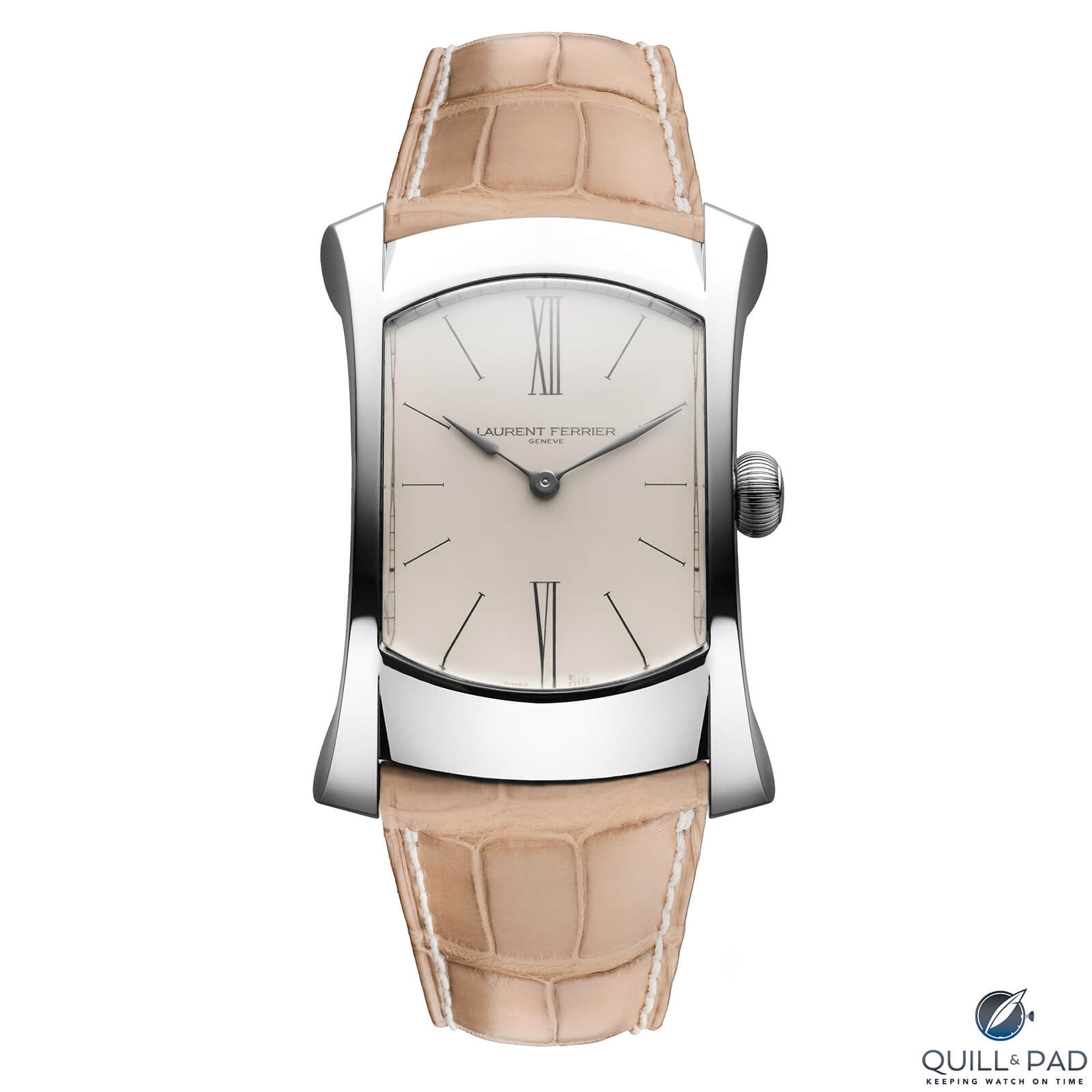
Laurent Ferrier Bridge One with white enamel dial
Second, Bridge One channels its source material with invention and grace. The actual Passarelle de l’Ile structure embodies early industrial age-of-steam imagery in miniature; not all elements are suited to a watch. The Geneva thoroughfare’s silhouette profile is a perfect match for the Bridge One’s vaulted camber, but detail work on the watch reveals a confident design team ready and waiting with ideas where the muse would not suffice.
Rivets, rust, and the hard geometries of nineteenth-century structural engineers were left suspended over the Rhone; Bridge One secures its elegance with mirror-polished shoulders, concave flanks, compound curves, and a seamless exterior.
Nomos Glashütte Autobahn charts an architectural course
Nomos Glashütte and Berlin-based architect Werner Aisslinger charted a similar course as Laurent Ferrier in the conception of the 2018 Autobahn model. Both the design teams of Nomos Glashütte and Laurent Ferrier tackled the challenge of translating works of pure architectural engineering into articles of luxury design. Laurent Ferrier chose a bridge; Nomos Glashütte chose race tracks.
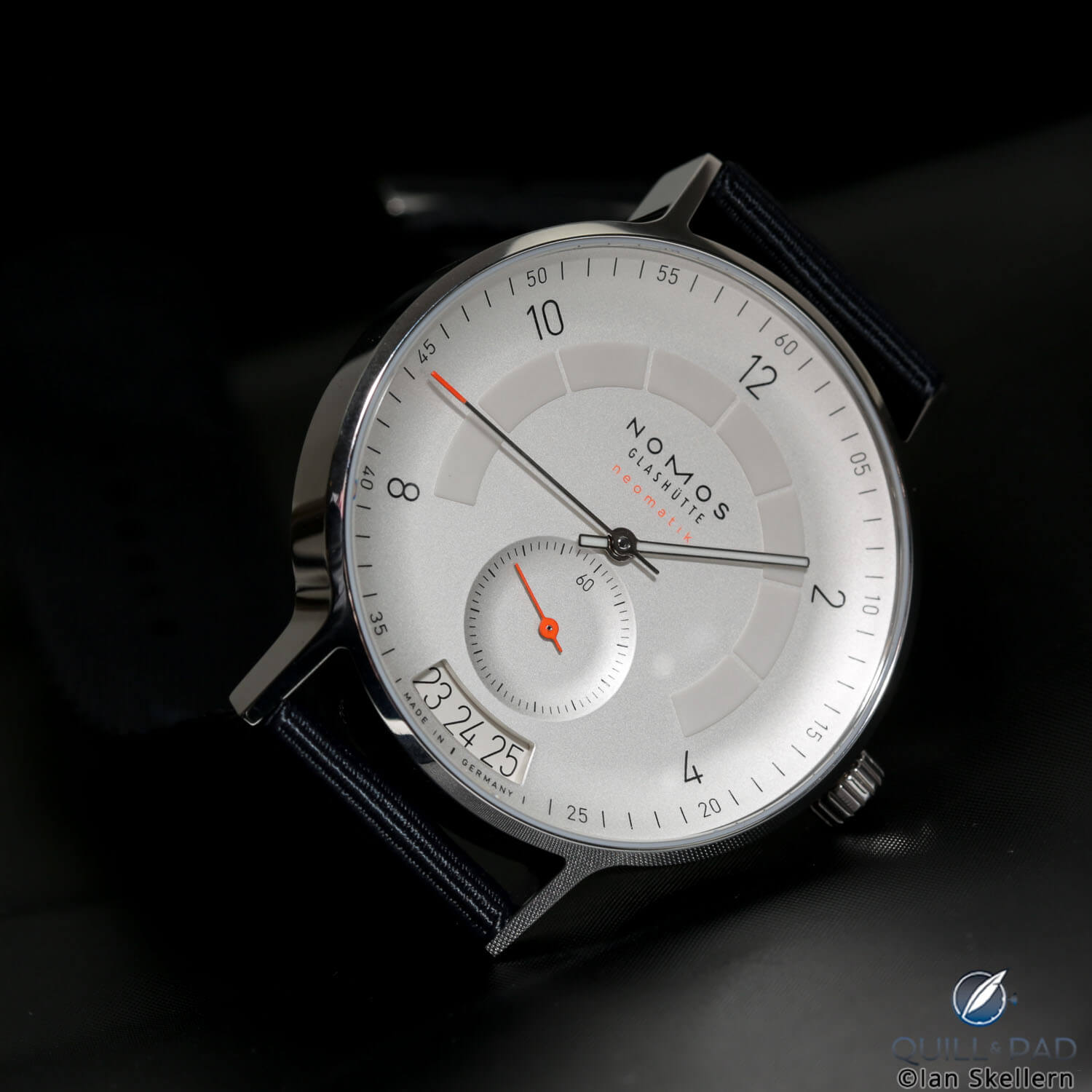
Nomos Autobahn neomatik Datum 41
Specifically, Nomos Glashütte chose ancient and primitive competition parcours including Brooklands of England, Autodromo Nazionale Monza in Italy, and Indianapolis Motor Speedway in the United States.
The challenge facing Aisslinger and partner Tina Bunyaprasit was one of scale: how does a miles-long racing venue translate into a 41 mm watch? As with the Bridge One, the answer lies in avoiding literalism and capturing the emotional essence, not the reality of the structure.

Banked corners at the historic Brooklands race track in the UK
Monza, Indianapolis, and Brooklands are banked tracks with length, width, and height. The romantic imagery of ancient grand prix and Indy cars defying gravity on the high banks at suicidal speeds cuts to the heart and soul of each track’s emotional appeal. And that is exactly the element that Aisslinger and co. translated into the Autobahn.

Nomos Autobahn midnight blue
Like Bridge One, the Autobahn imagery is distilled but not plagiarized. The Autobahn’s dial slopes dramatically from its bezel to its cannon pinion, with the majority of the camber confined to the region flanking the hours; the center is almost flat. At 6 o’clock, a mirror image of the cupped dial serves as the small seconds register.
The Autobahn is a handsome and inventive watch; no knowledge of vintage race tracks is necessary to appreciate the nuance of the double-dished dial.
Urwerk UR-105 CT Streamliner: Art Deco New York
Urwerk co-founder and design lead Martin Frei faced a different challenge than Nomos Glashütte and Laurent Ferrier. While bridges and racetracks are purely functional works of architecture, the 1930s towers of New York embodied considerable style for style’s sake. Art Deco New York – or an idealized version of it – was the guiding light behind the Urwerk UR-105 CT Streamliner.
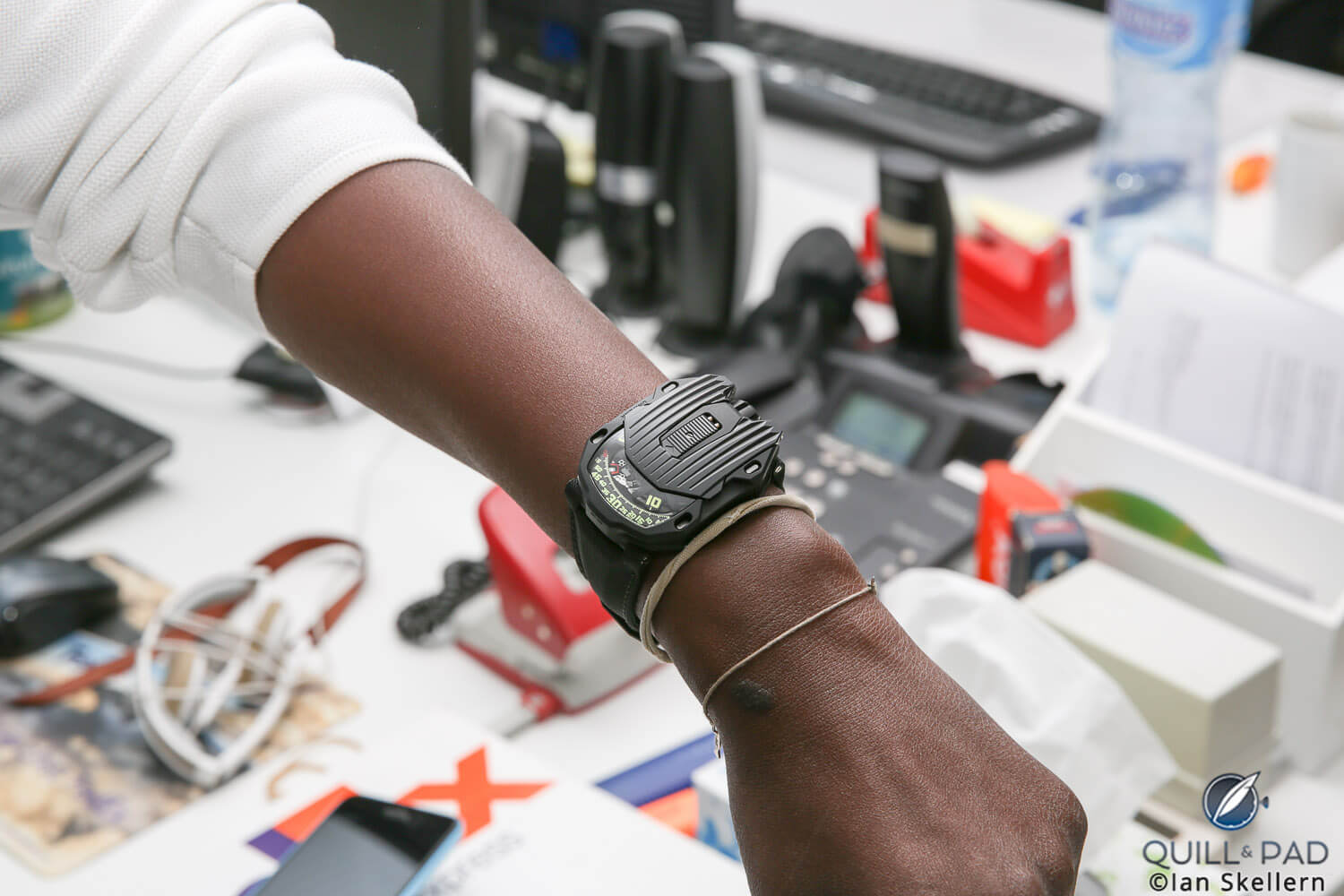
Urwerk UR-105 CT Streamliner on the wrist
Technically Urwerk’s twentieth-anniversary commemorative model, the Streamliner was designed to pay tribute to Frei and co-owner Felix Baumgartner’s formative New York experience during Urwerk’s early years.
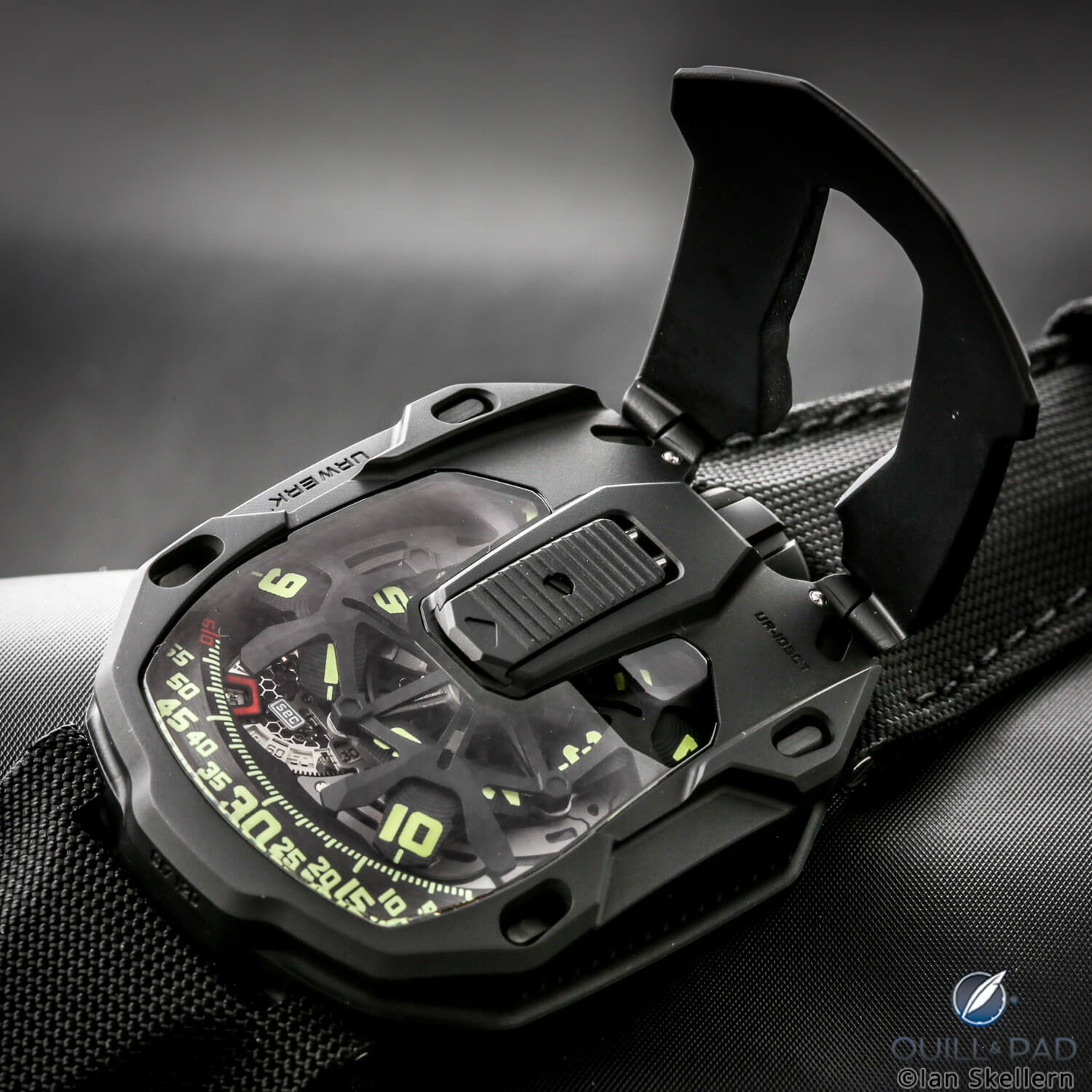
Urwerk UR-105 CT Black with cover open
Frei drew deeply on the strakes, gadroons, seams, tiers, and vaulted peaks of the Chrysler Building, Empire State Building, and 30 Rockefeller Plaza. The literal forms of the structures were removed and the details focused to fit the format of a 53 mm watch case.
Each of these inspirations is evident in the final UR-105 CT. With its retractable upper case locked in place, the Urwerk Streamliner evokes the soaring verticals of Empire State and 30 Rock. Case cover erect, the skeletonized Uwerk “wandering hours” carousel recalls the radiant metallic mural of Empire State’s lobby and the Chrysler’s machine-age peak.
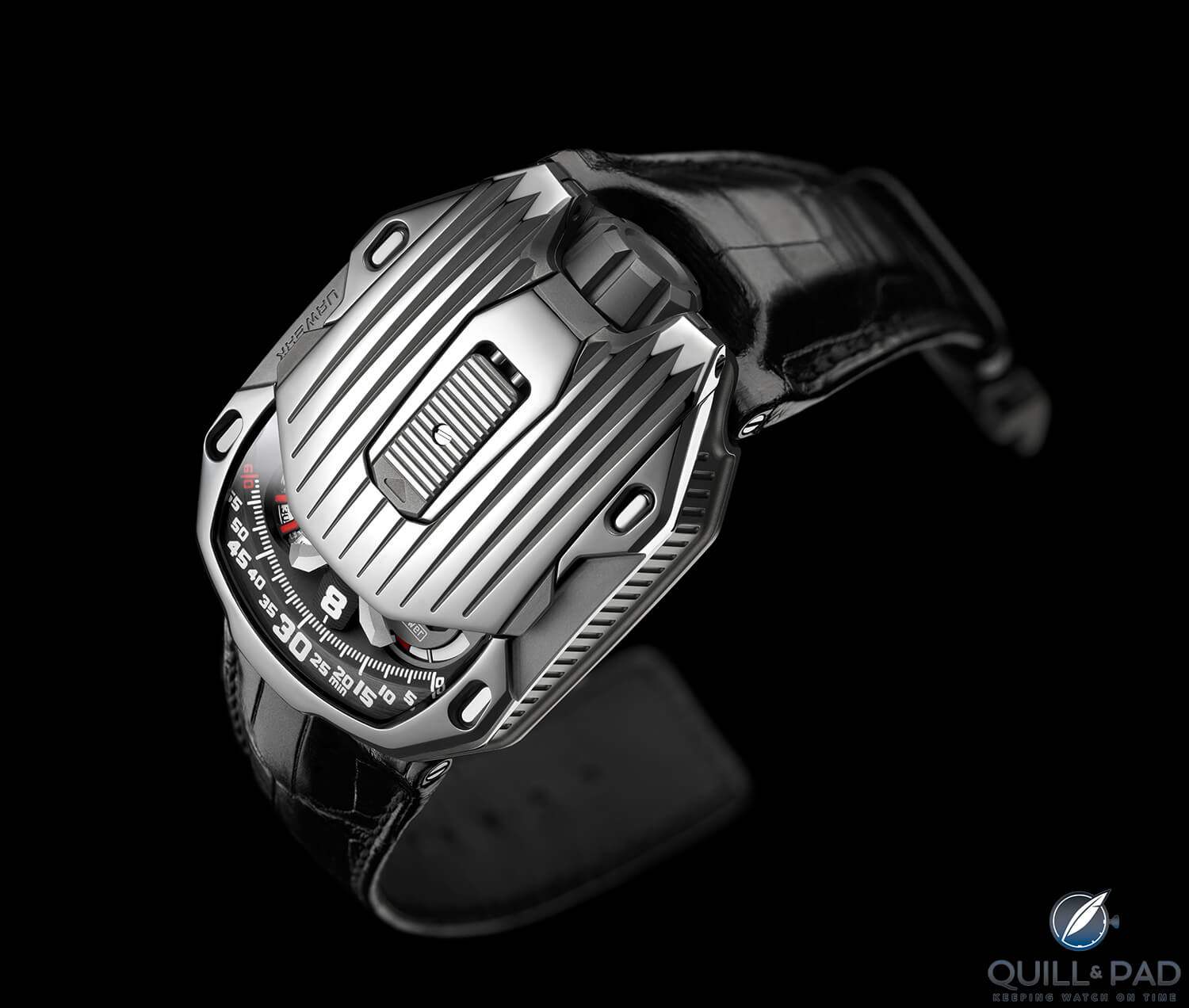
Urwerk UR-105 CT in polished steel/titanium
For good measure, the UR-105 CT was available in an optional polished steel variant to hammer home the impact of Chrysler’s chrome canopy.
If one theme has emerged from this survey, it is the success of watch designs that abstract from their architectural basis. A strong effort is one that captures a feeling without stooping to caricature or pastiches.
Mido IBA: inspired by Frank Lloyd Wright
Remarkably Swatch’s Mido proved an unlikely exception to the rule with the 2017 Inspired by Architecture (IBA) limited edition.
Mido is an entry-level luxury brand that does a good deal well, including the reasonable pricing of its watches. Exact service prices for Mido products are listed prominently on the company’s website. And with silicon technology, chronometer certifications, and extended power reserves, Mido offers substantial features for the money. But its designs generally are conservative, derivative, and anonymous.
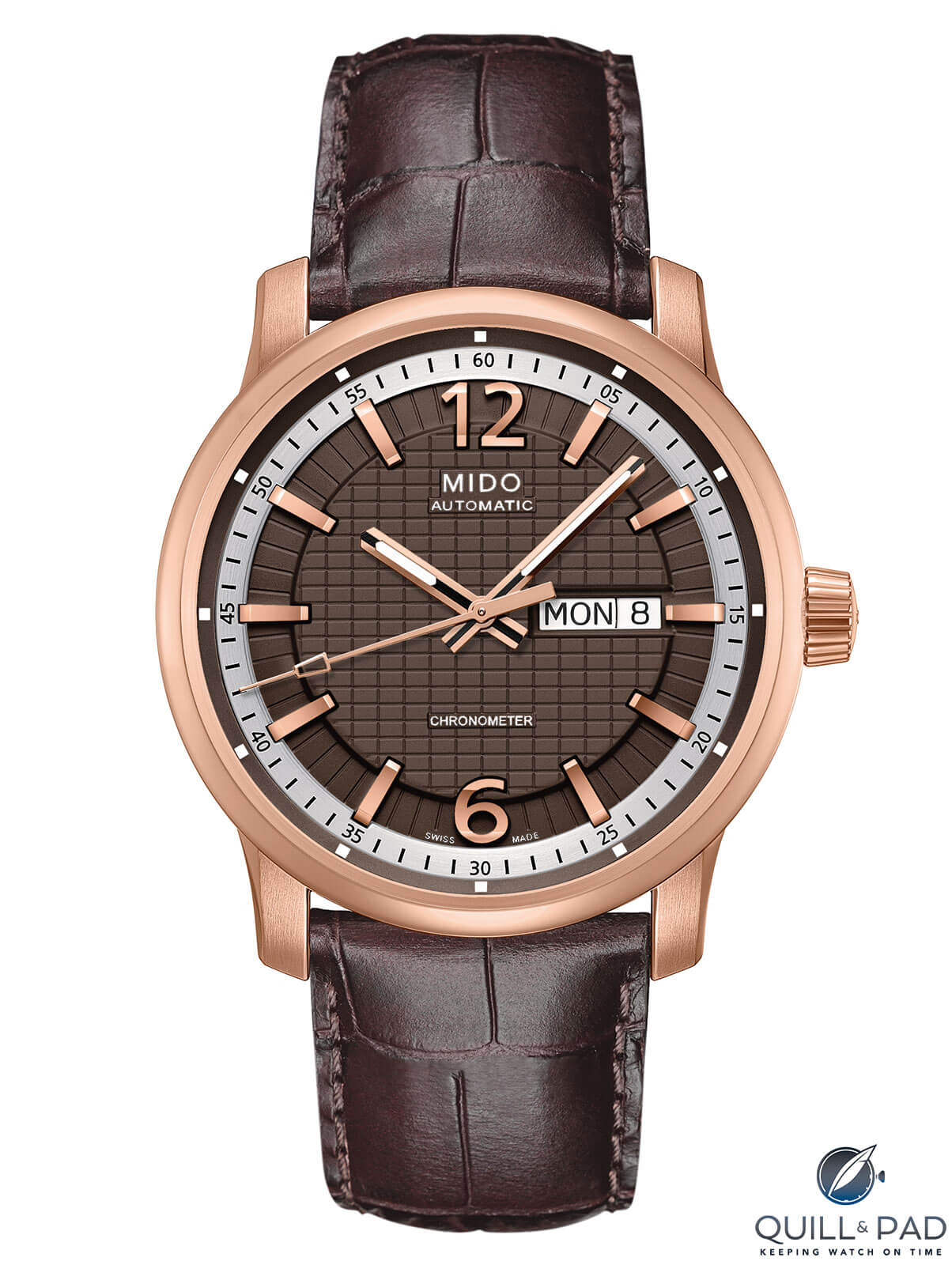
Mido Inspired by Architecture Great Wall
Previous Mido dalliances with architecture did little to counter this reputation. The 2012 All Dial rollout featured one limited edition with the Roman Colosseum – its purported inspiration – on the case back; nothing else about the watch suggested this link.
The Great Wall from 2013 featured a vaguely stonemason dial motif; the 2015 trial run of the Inspired by Architecture fan poll likewise fell flat with an unconvincing Big Ben clock tower watch. Subtlety and abstraction weren’t working for team Mido.
All of this changed following a brand-sponsored fan poll in 2016. Apparently, Mido’s unique failure was not going far enough; for once, literalism won the day.
The shocking appeal of the IBA design belies both its parent brand’s reputation and its hyper-literal design appropriation. Mido basically built a 40 mm model of Frank Lloyd Wright’s Solomon R. Guggenheim Museum for the wrist.
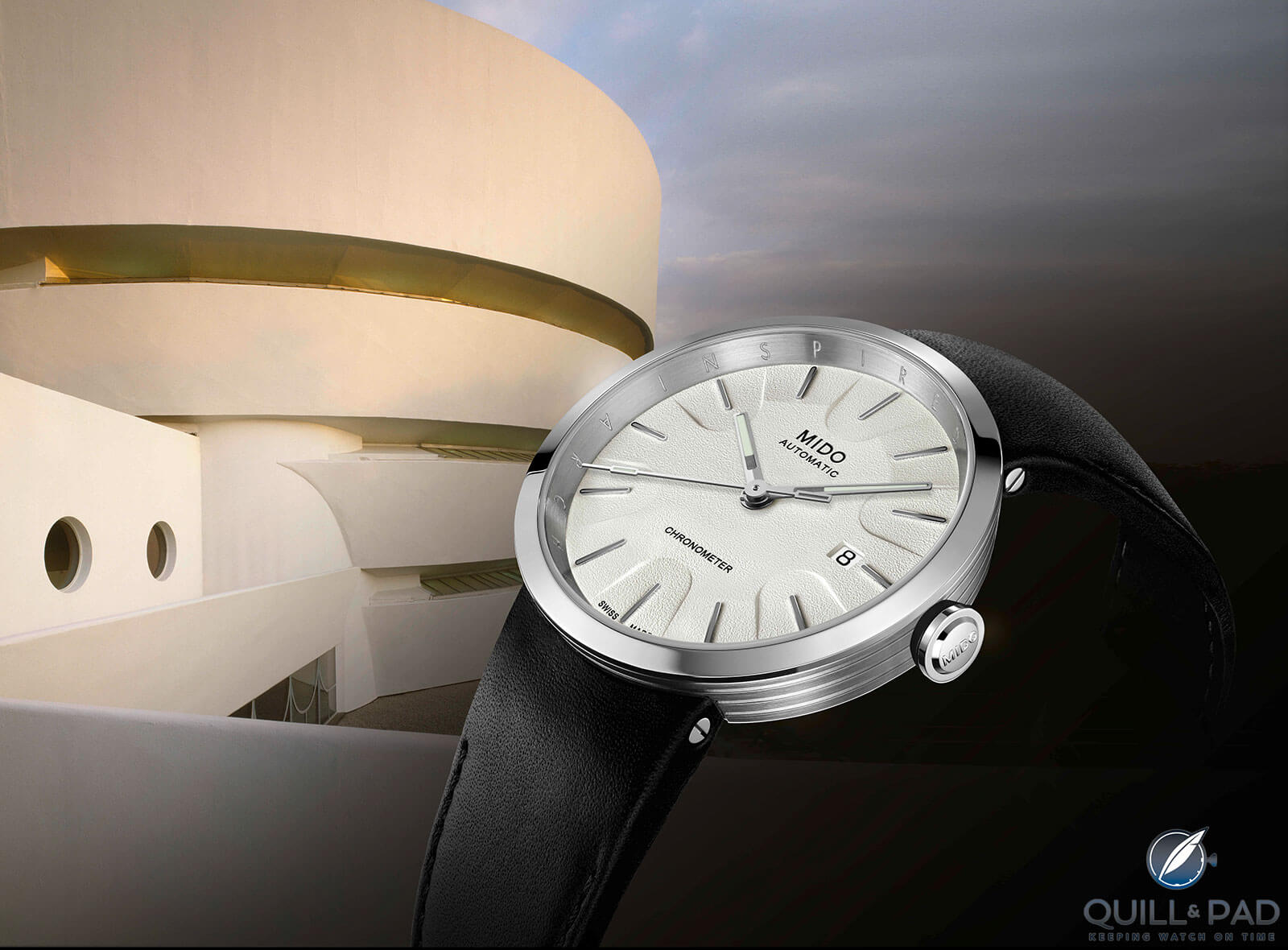
Mido Inspired by Architecture Guggenheim
Rather than target a “feeling” or “impression,” Mido’s designers started by grafting the Guggenheim’s winding spiral gallery to a strap. Minimalist hinge lugs were chosen to keep the conical case unmarred by traditional lug profiles. The inset spiral and conical rise of the museum were expropriated intact. Outer facing spirals were satin finished while the recesses were executed in high polish.
The IBA’s off-white dial base drew directly on the interior tones of the Guggenheim’s main gallery, and a rusticated texture recalls the museum’s raw reinforced concrete construction. Scalloped hour recesses matched exactly the skylight outline of the gallery’s floating atrium.
In spite of its pronounced vertical sweep and plunging flange, the case remained a delightfully compact 12 mm in height.
From a design standpoint detail density, modest size, and boldness were the Mido IBA’s core strengths. The team could have designed the case and dial, popped a cork, and called it a day. But superb ergonomics were ensured via those hinge lugs, and Mido gilded the lily by adding its flagship C.O.S.C.-certified 80-hour automatic Caliber 80 Si with silicon hairspring.
Five hundred examples of the Frank Lloyd Wright-powered IBA were sold for $1,590 each. The watch looks as compelling on the wrist as it does in isolation, and its unlikely success proves that in watch design as in architecture, it’s better to follow inspiration than rules.
Le Corbusier and Girard-Perregaux
Architecture is more than applied engineering; it defines the built landscape and daily experience. The impact of architects is a daily feature of almost all lives, and few architects can claim the far-ranging impact of modernist pioneer Charles-Édouard Jeanneret, better known as Le Corbusier.
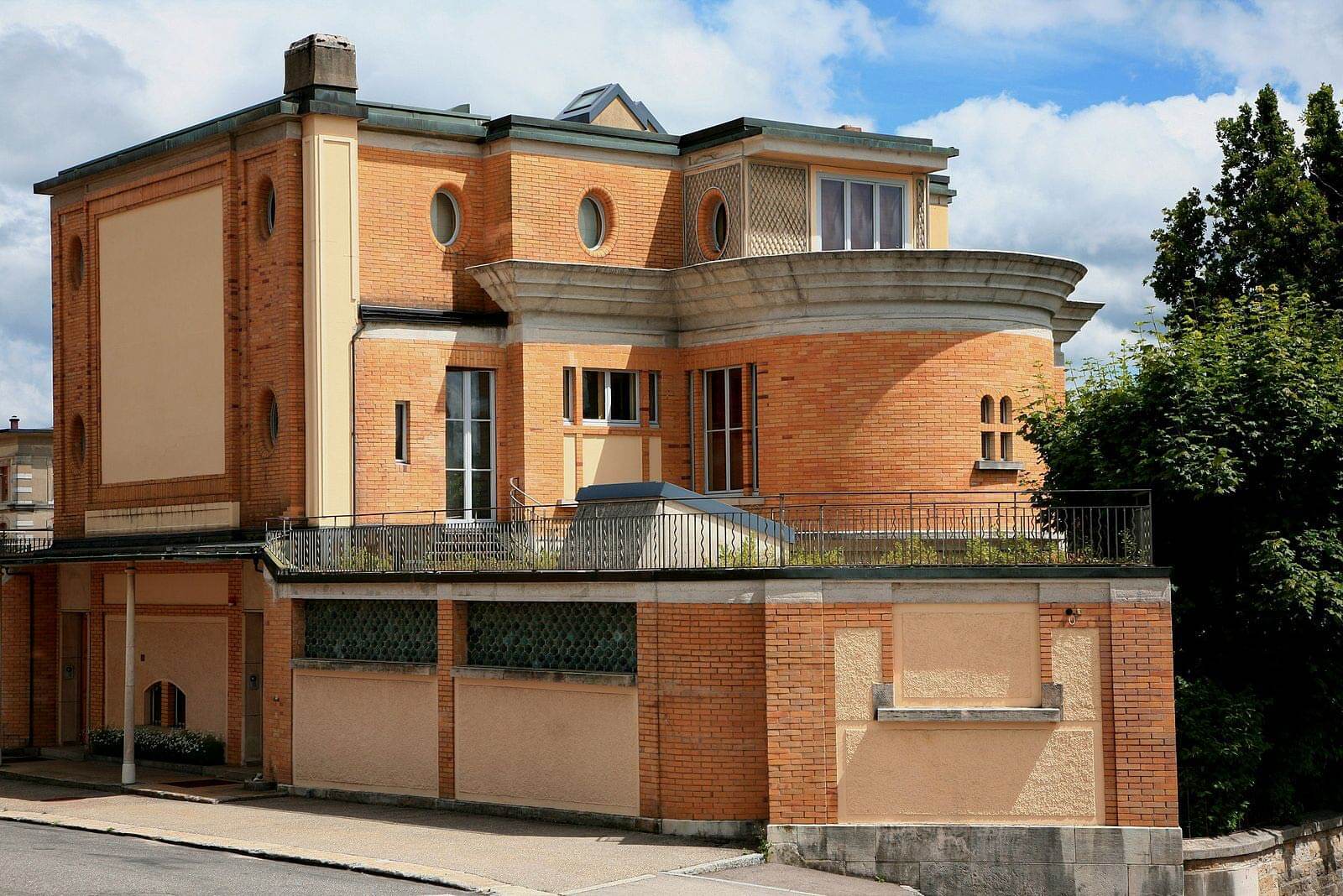
Le Corbusier’s Villa Turque in La Chaux-de-Fonds, Switzerland was commissioned in 1912 by watchmaker Anatole Schwob (photo courtesy Schwizgebel/Wikipedia)
And in 2012, Girard-Perregaux honored the 125th birthday of its fellow La Chaux-de-Fonds native with the Le Corbusier Trilogy.
Born and educated amid the local watch industry, Jeanneret learned related craft arts at an early age. His architectural career spanned 60 years and multiple continents, while his portfolio of work spanned affordable housing blocks (Quartiers Modernes Frugès), luxury homes (Villa Savoye), and even full cityscapes (Chandigarh, India).
Jeanneret was both a master of his craft and an influential author who promulgated the philosophical basis for modern architecture.
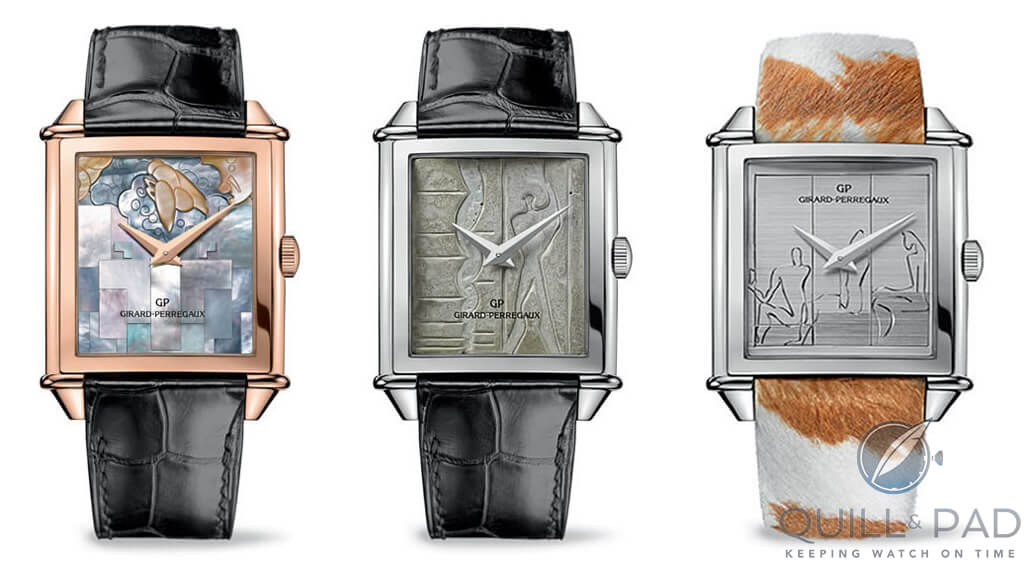
Girard-Perregaux’s Le Corbusier Trilogy
Girard-Perregaux’s Le Corbusier Trilogy acted as a symbolic tribute to three eras of Le Corbusier’s career. Each model was based on the Vintage 1945 collection of cambered rectangular watches and each was defined by a unique choice of materials for strap, case, and dial. Power was provided by GP’s automatic manufacture Caliber 3300, but this series was less about the movements and more about the narrative.
The pink gold first model, appropriately christened La Chaux-de-Fonds, pays tribute both to the region’s heritage and Le Corbusier’s formative years.
The dial salutes his father’s work in the watch, clock, and jewelry space, Jeanneret’s own education at the local school of arts, and the architect’s development as a fine art practitioner in his own right. Above all, the first watch of the series re-creates an early bas-relief by Le Corbusier during his early days as a commissioned artist in the town of his birth.
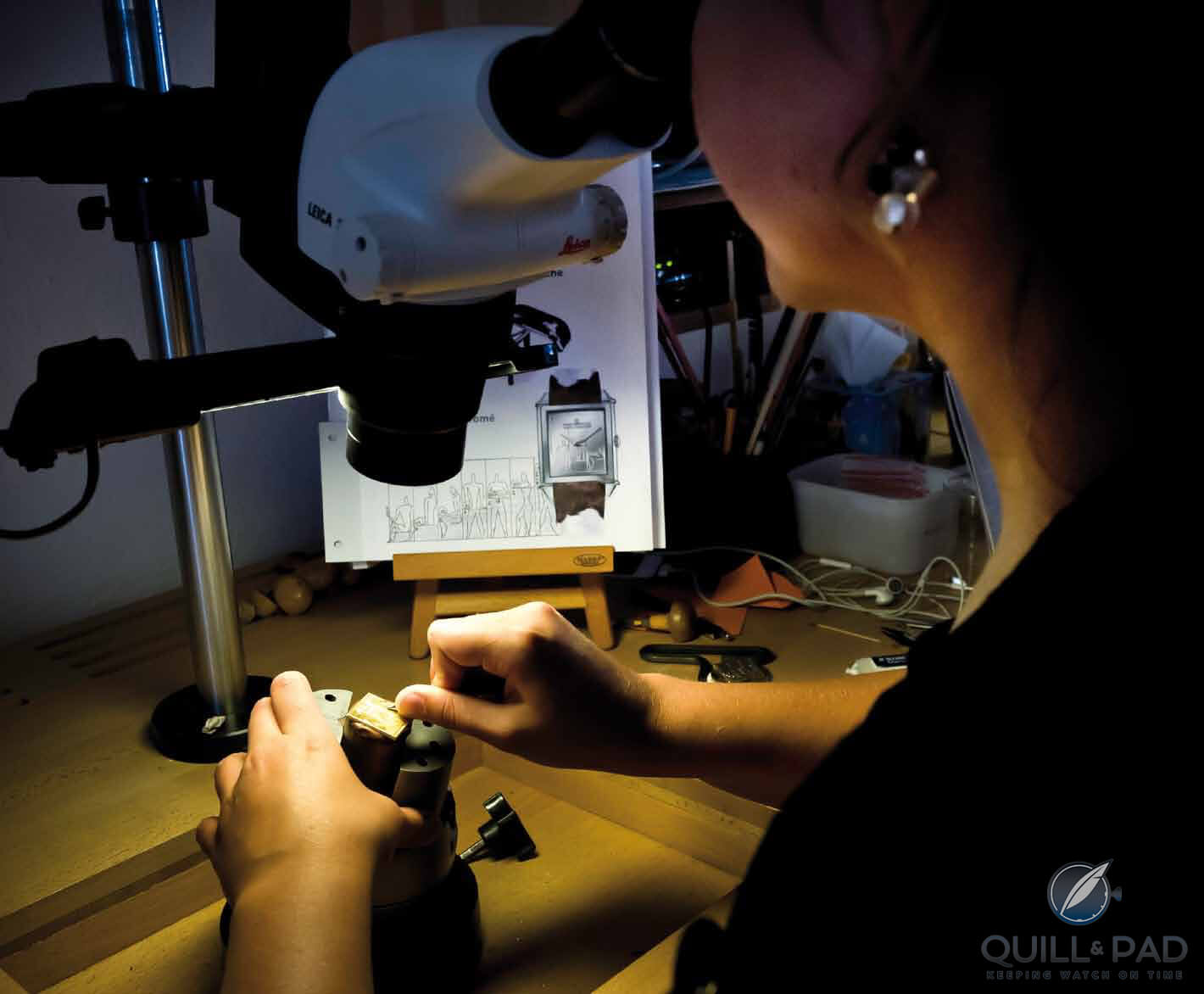
Engraving a dial of the Girard-Perrgaux Le Corbusier Marseille (photo courtesy GP/patriceschreyer.com)
Seven days per dial were required for Girard-Perregaux’s artisans to re-create the original work using a combination of multicolored mother-of-pearl sections and marquetry techniques. As with all three models of the set, only five pieces were made in a pink gold case.
The steel-cased second model, Paris, highlights Jeanneret’s emergence as a complete practitioner capable of designing both structures and the furnishings within. This watch recalls the period in which the artist relocated to the City of Light and officially adopted the trade moniker Le Corbusier.
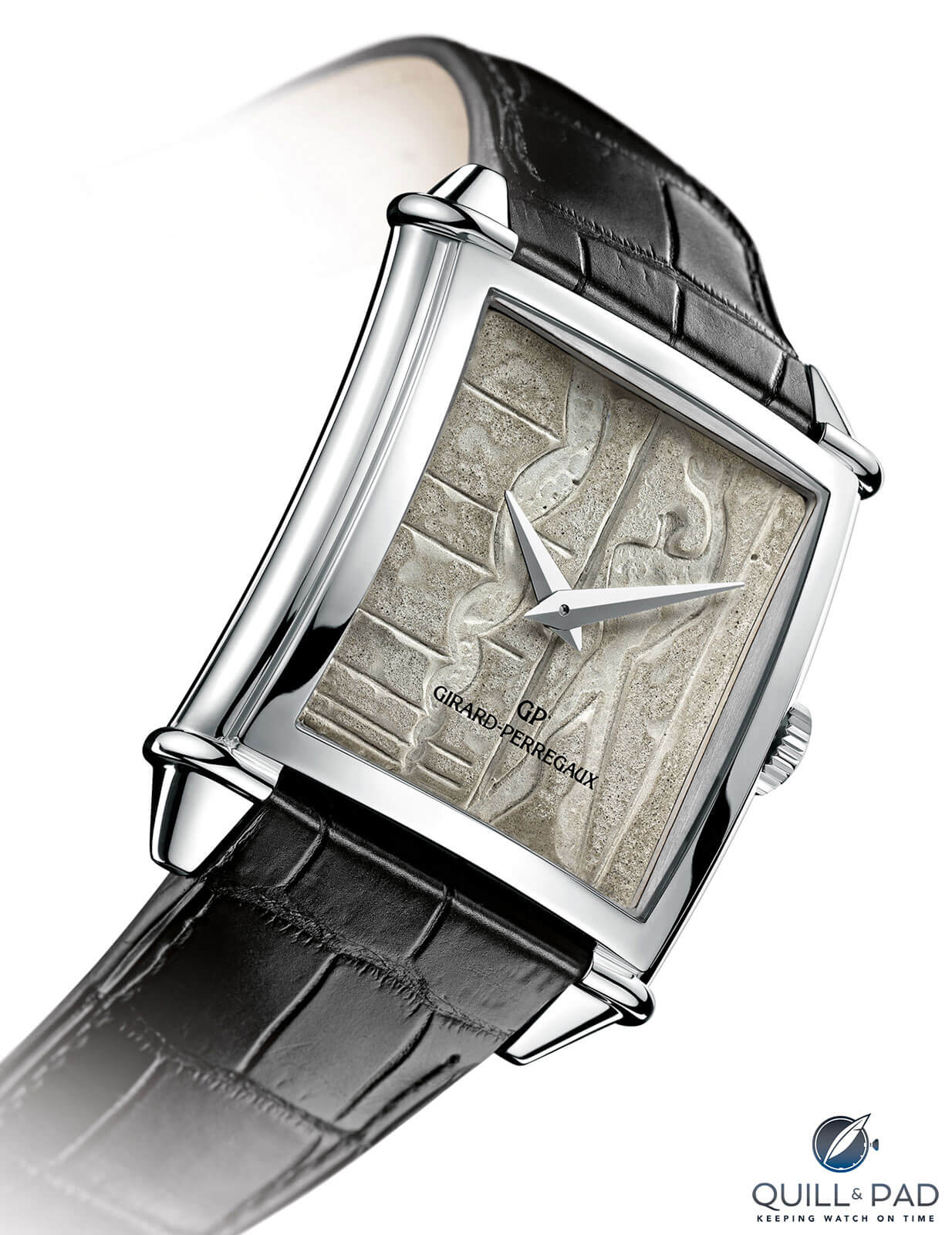
Girard-Perregaux Le Corbusier Marseille in steel
The highlight of this model is a metal dial engraved with the imagery of furniture crafted with modern materials – mostly steel – and minimalist frames. Fusing natural and industrial materials, the architect added natural hides to his signature metal chairs; a watch strap of genuine cowhide – complete with fur – completes the homage.
Watch three, the stainless steel Marseille, embodies the culmination of Le Corbusier’s philosophy of architecture and its relationship to human needs. Girard-Perregaux crafted a concrete dial portraying the architect’s concept of the Modulor, a math-based ratio of human scale to structural scale. Le Corbusier famously incorporated Modulor principles in his 1952 mass-housing project Cité Radieuse in Marseille, France.
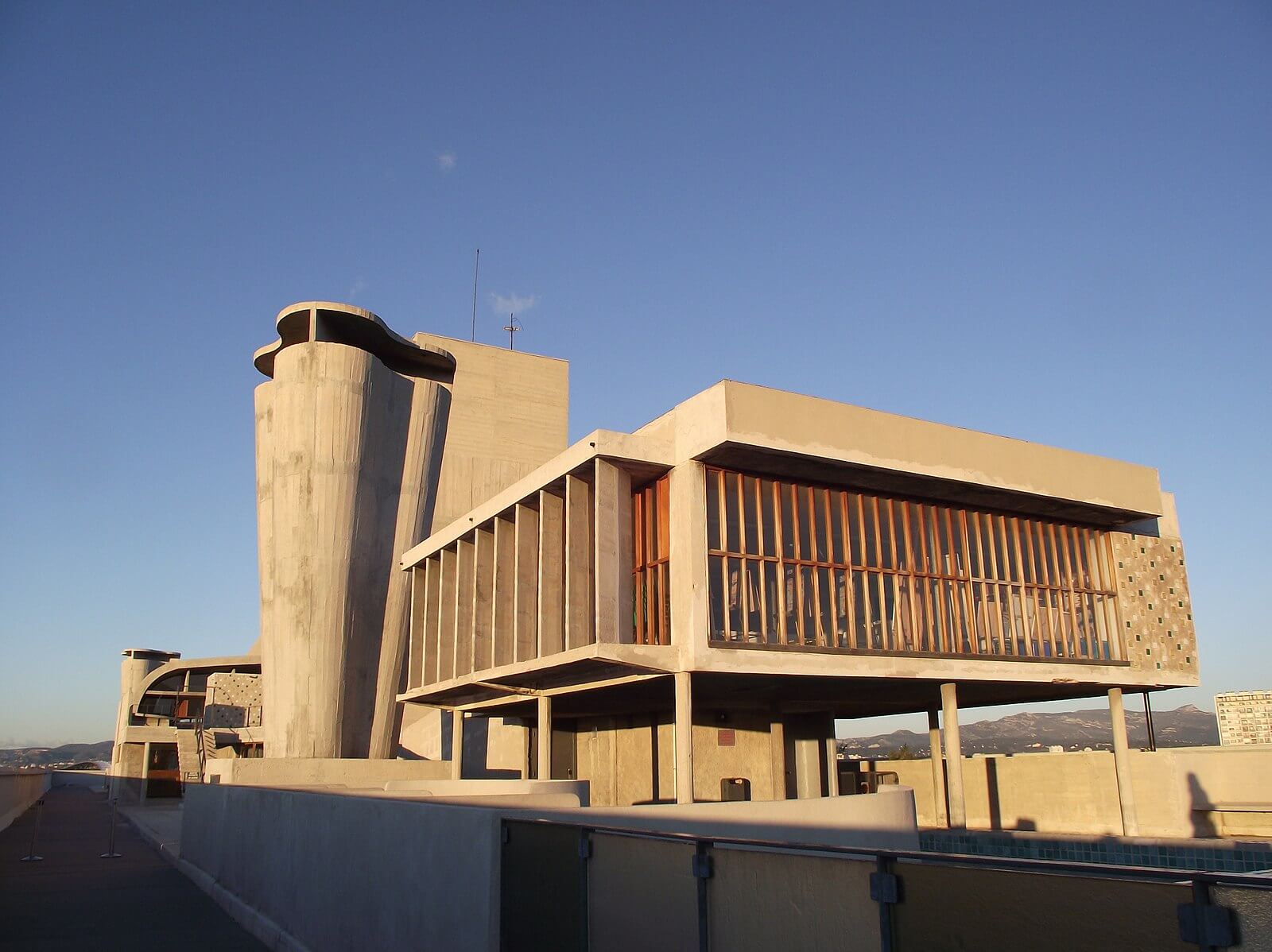
Cité Radieuse in Marseille, France (photo courtesy Fred Romero/Wikipedia)
In detail, the building’s minimally-finished concrete exterior bears the image of the architect’s Modulor key depicting a human form in relation to mathematically determined ratios of scale. Girard-Perregaux’s artisans recreated the form and the material of this key on the dial of the Marseille watch.
The process of pressing, drying, and shaping the dial consumed three days for each example built. By popular demand, this final model was re-issued as a series of 50 pieces in 2015.
Orders of magnitude spawn the chasm between wristwatch and architectural scales. But as with all matters of aesthetics, the heart rules. The emotional resonance between beauties great and the small is the tie that binds the architect, the watchmaker, and the watch collector.
Quick Facts Laurent Ferrier Bridge One
Case: 44 x 30 mm, stainless steel
Movement: manual winding Caliber LF 107.01, 80-hour power reserve, 3 Hz/21,600 vph frequency
Functions: hours, minutes, seconds (only on grey dial version)
Price: $37,000 (grey dial); $42,000 (enamel dial)
Quick Facts Nomos Glashütte Autobahn Neomatik
Case: 41 x 10.5 mm, stainless steel
Movement: automatic Caliber DUW 6101 with Swing System escapement
Functions: hours, minutes, seconds; date
Price: €3,800
Quick Facts Urwerk UR-105 CT Streamliner
Case: polished steel bezel/titanium base or blackened steel bezel/titanium base, 53 x 39.5 x 17.3 mm, flip-up dial cover
Movement: automatic Caliber UR 5.03, with twin turbine regulation, 48-hour power reserve
Functions: wandering hours; minutes, digital seconds; power reserve indicator
Price: 65,000 Swiss francs (tax excluded)
You may also enjoy:
Nomos Glashütte Autobahn: Pedal To The Metal!
Road Trip: Cruising The Fast Lane To Cologne In A Corvette With Nomos And Chopard
Leave a Reply
Want to join the discussion?Feel free to contribute!





















































The LF Bridge One just hypnotizes me. It’s a bit too thick, too expensive, and doesn’t have a natural escapement, but I want it.
Would like to see a watch design influenced by Gaudi.
Ooooh, so would I!
For some reason I think the people who design the Metiers D’Art pieces at Vacheron would probably do it very well.
Hi Gil, I agree that Vacheron seems well equipped to ace this category of design. It’s a niche, but so are masks, hot air balloons, and animal images, and that hasn’t proved a previous impediment to VC’s design department!
Best,
Tim
Exactly. And ideally they could do something based on the vivid, alien beauty of Casa Batllo.
Btw, big fan of your videos.
Tim,
Interesting article. The similarity in Mido Guggenheim watch silhouette to the actual museum you describe in the article is nicely shown in the attached image.
https://static.watchtime.com/wp-content/uploads/2017/10/Mido_InspiredbyArchitecture_LE_dialCU_1000.jpg
Thank you for reading my work, William. I’m a fan of the Mido IBA Guggenheim and could even see myself owning the watch in the future.
Best,
Tim